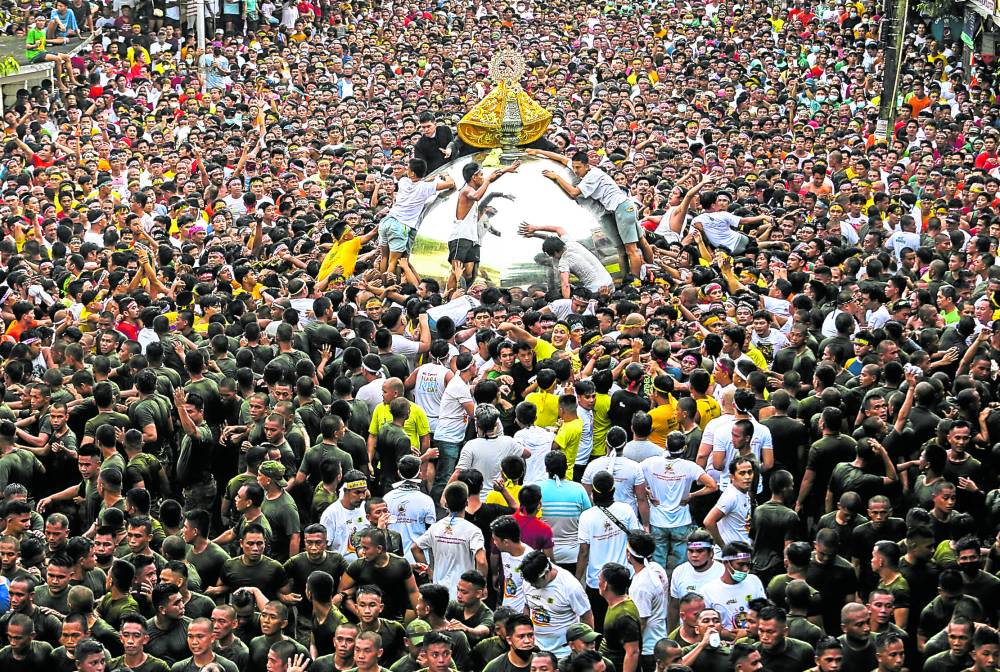
‘VIVA LA VIRGEN’ Thousands of devotees join Friday’s “traslacion” procession of Our Lady of Peñafrancia in Naga City, the first time it has been held since 2020, when the COVID-19 pandemic was declared. —MARK ALVIC ESPLANA
NAGA CITY — Braving the thick crowd at the Plaza de Covarrubias outside the Our Lady of Peñafrancia Shrine in this city on Friday, Antonia Talde, 57, and her wheelchair-bound husband, Nelson, 59, waited patiently for the images of the Bicol patroness and Divino Rostro (The Holy Face of Jesus) to start their journey via the traslacion procession.
Nelson, who has been suffering from rheumatism, was among the pilgrims with disabilities who traveled from Legazpi City, some 80 kilometers away, to witness the largest Marian procession in Asia, after being canceled for two years.
“We went here because of my sister-in-law’s suggestion that we join the traslacion,” Antonia told the Inquirer. It was their first time joining the foot procession from the shrine to Naga Metropolitan Cathedral.
More than half a million devotees—according to the estimates of the City Events Protocols and Public Information Office—flocked to the pilgrim city to join the traditional procession marking the start of the nine-day novena for Our Lady of Peñafrancia.
The festivities will end with the fluvial procession on Naga River on Sept. 17 when the images of Divino Rostro and the Virgin, locally called “Ina,” return from the Naga Metropolitan Cathedral to the Basilica Minore de Peñafrancia.
The images will be transported on a pagoda and accompanied by several small boats.
Devotees typically board the pagoda and boats or stand on the riverbank with lit candles.
Protocols
To avoid the spread of COVID-19, the devotees were not allowed to touch and kiss the image of Ina. Organizers also decided to hold a mobile procession instead of the usual foot procession.
But devotees swarmed the image as soon at it came into view along the city’s streets past 4 p.m.
In a public advisory a month before the festivities, Mayor Nelson Legacion required pilgrims 18 years old and older to have at least the first booster, while those between 12 and 17 years old must have at least a second shot. Younger pilgrims, aged 7 to 11, must have at least one shot, he said.
Event organizers, volunteers and the voyadores (male devotees) were required to have two booster shots.
But organizers said they could not monitor every devotee present to facilitate easy mobility.
“If we check everyone, that would just result in crowding and we would have violated the COVID-19 protocols,” Fr. Juan Pablo Carpio, parish priest at the Basilica, said at a press briefing in August.
Swarm of devotees
In the past, pilgrims would push and pull their way to the andas to get a chance to wipe handkerchiefs on images. But this year, police officers and military personnel were tasked to prevent the pilgrims from being disorderly around the images.
Still, devotees managed to swarm the image.
The image of Divino Rostro left the Plaza de Covarrubias at 3:35 p.m., while the image of Ina left at 4:20 p.m.
The Divino Rostro made its journey for over an hour and reached the cathedral at 4:45 p.m., while Ina reached its temporary shelter around 6 p.m. amid joyful cries of “Viva La Virgen!”
This year’s celebration of the devotion to the Bicol patroness, Our Lady of Peñafrancia, is on its 312th anniversary, having started in 1710.
Many historical accounts of miracles were associated with the image after it was carved, the first being the resurrection of the sacrificed dog whose blood was used to paint the image. The dog was said to have come back to life after being thrown into the Naga River, enabling it to come home to its master.